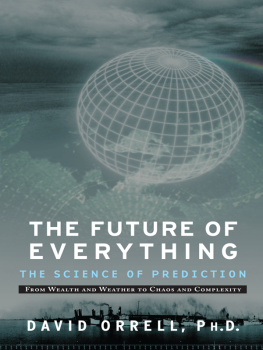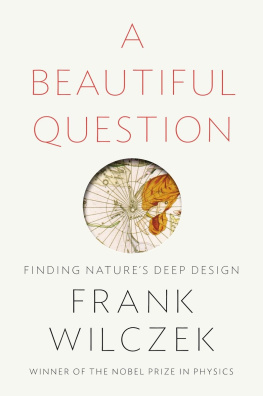Acknowledgments
Thanks to:
Jennie Rubio and Joseph Camalia for their enthusiastic support of the project and incisive editorial advice.
Peter Woit and Robert Smith for providing valued comments on the manuscript.
My agent Robert Lecker for his guidance over the years.
My former colleagues at the Superconducting Supercollider Laboratory, particularly Jay Jayakumar, Jon Turner, Chris Haddock, Greg Snitchler. We didnt find any new particles, but we shared some good stories.
My parents, who showed me in different ways that numbers and words do mix.
My wife and family for being both beautiful and true.
Bibliography
Abella, A. Soldiers of reason: The Rand Corporation and the rise of the American empire. Orlando: Harcourt, Inc., 2008.
Abraham, R. The broken chain. 24 November 2005. http://www.ralph-abraham.org/articles/MS%23117.Kepler/kepler02.pdf (accessed 30 March 2012).
Bhikkhu, T. Acintita Sutta Unconjecturable. Vol. 3 in Handful of Leaves: An Anthology From the Anguttara Nikaya. Valley Center, CA: Sati Center for Buddhist Studies & Metta Forest Monastery, 2003.
Adams, D. The original hitchhiker radio scripts. Edited by G. Perkins. London: Pan Books, 1985.
Adler, R. Ultimate guide to the multiverse. New Scientist, 28 November 2011.
Alberti, L.B. The ten books of architecture: The 1755 Leoni edition. Mineola, NY: Dover, 1986.
Alexander, S. Space, time, and deity. London: Macmillan, 1920.
Alighieri, D. Il convito: The banquet of Dante Alighieri. Translated by E.P. Sayer. London: G. Routledge and Sons, 1887.
Allen, W. Getting even. New York: Random House, 1971.
Alpher, R.A., H. Bethe, and G. Gamow. The origin of chemical elements. Physical Review 73, no. 7 (1948): 803804.
Amaldi, U., W. de Boer, and H. Furstenau. Comparison of grand unified theories with electroweak and strong coupling constants measured at LEP. Phys. Lett. B 260 (1991): 447455.
Amis, M. The information. New York: Vintage Books, 1995.
Anderson, C.D. The positive electron. Physical Review 43, no. 6 (1933): 491494.
Anderson, P.W. More is different. Science 177, no. 4047 (1972): 393396.
Anker, S., and D. Nelkin. The molecular gaze: Art in the genetic age. Cold Spring Harbor, NY: Cold Spring Harbor Laboratory Press, 2004.
Anonymous. Enrico Fermi dead at 53; Architect of atomic bomb. The New York Times, 23 November 1954.
. 1957: Sputnik satellite blasts into space. BBC, 4 October 1957. http://news.bbc.co.uk/onthisday/hi/dates/stories/october/4/newsid_2685000/2685115.stm (accessed 1 January 2012).
. Glimpses of superhistory. CERN Courier, 26 February 2001.
. Faces and places, Yuval Neeman. CERN Courier, 25 July 2006a: 6.
. Dismal science, dismal sentence. Economist, 9 September 2006b.
. 248-dimension maths puzzle solved. BBC News, 19 March 2007. http://news.bbc.co.uk/1/hi/6466129.stm (accessed 25 November 2011).
. The other-worldly philosophers. Economist, 16 July 2009.
. Trader was not a hoaxer, says BBC. BBC News, 28 September 2011a. http://www.bbc.co.uk/news/business-15078419 (accessed 30 September 2011).
. Big chill on way. The Sun, 18 October 2011b.
. Neutrinos and multiverses: a new cosmology beckons. New Scientist, 28 November 2011c.
Appelbaum, B. Inside the fed in 06: Coming crisis, and banter. New York Times, 13 January 2012.
Aristotle. Aristotles politics. Translated by B. Jowett. New York: Modern Library, 1943.
. Metaphysics. Translated by W.D. Ross. Sioux Falls, SD: NuVision Publications, 2009.
Arrow, K.J., and G. Debreu. Existence of a competitive equilibrium for a competitive economy. Econometrica 22 (1954): 6590.
Atkinson, N. Q&A with Brian Cox, (accessed 1 September 2011).
Bachelier, L. Thorie de la spculation. Annales Scientifiques de lcole Normale Suprieure 3, no. 17 (1900): 2186.
Bacon, F. Of beauty. In Bacons essays: With annotations, edited by R. Whately, 395396. London: J.W. Parker & Son, 1856.
Bak, P. How nature works: The science of self-organized criticality. New York: Springer-Verlag, 1996.
Bakan, J. The corporation: The pathological pursuit of profit and power. New York: Free Press, 2004.
Barfield, O. Saving the appearances: A study in idolatry. 2nd Edition. Middletown: Wesleyan University Press, 1988.
Barr, S.M. Modern physics and ancient faith. Notre Dame, IN: University of Notre Dame Press, 2003.
Barres, B. Does gender matter? Nature 442 (2006): 133.
Barrow, J.D. New theories of everything. Oxford: Oxford University Press, 2007.
. Cosmic imagery: Key images in the history of science. London: Bodley Head, 2008. Bateson, M.C. What is the most important invention in the past two thousand years? From: Mary Catherine Bateson. Edge.org . Edited by J. Brockman. 10 February 1999. http://edge.org/discourse/invention.html (accessed 8 January 2012).
Baxter, J. Age of unreason. Guardian, 22 June 2004.
Beinhocker, E.D. Origin of wealth: Evolution, complexity, and the radical remaking of economics. Boston: Harvard Business School Press, 2006.
Bell, J.S. On the Einstein-Podolsky-Rosen paradox. Physics 1 (1964): 195200.
Bentham, J. An introduction to the principles of morals and legislation. Oxford: Clarendon Press, 1907.
Berger, J. Ways of seeing. London: British Broadcasting Corporation; Penguin Books, 1972.
Bernal, J.D. Dr. Rosalind E. Franklin. Nature 182, no. 154 (1958).
Bernanke, B.S. Commencement address at the Boston College School of Law. Newton, MA, 22 May 2009.
Beven, K. Environmental modelling: An uncertain future. London: Routledge, 2009.
Bizony, P. Atom. London: Icon, 2007.
Blake, W. The Tyger. In Songs of innocence and of experience: Shewing the two contrary states of the human soul. London: W. Blake, 1794.
Bohm, D. Quantum theory. New York: Prentice-Hall, 1951.
. Causality and chance in modern physics. Philadelphia: University of Pennsylvania, 1971.
. Wholeness and the implicate order. London: Routledge, 1980.
Bohr, N. On the constitution of atoms and molecules. I. Phil. Mag. 26 (1913): 1.
Borewein, J.M. Aesthetics for the working mathematician. In Mathematics and the aesthetic: New approaches to an ancient affinity, edited by N. Sinclair, D. Pimm, and W. Higginson. New York: Springer, 2006.
Born, M. Zur Quantenmechanik der Stovorgnge (Quantum mechanics of collision). Z. Phys. 37 (1926): 863.
Bouchaud, J.-P. Economics needs a scientific revolution. Nature, 2008: 1181.
Bowles, S. Did warfare among ancestral hunter-gatherers affect the evolution of human social behaviors? Nature 456 (2009): 326327.
Braque, G. Illustrated notebooks, 19171955. Translated by S. Appelbaum. New York: Dover, 1971.
Brockman, J. The third culture: Beyond the scientific revolution. New York: Simon & Schuster, 1996.
.A theory of roughness: A talk with Benot Mandelbrot. Edge, 20 December 2004. http://www.edge.org/3rd_culture/mandelbrot04/mandelbrot04_index.html (accessed 16 January 2012).
Bronowski, J. The common sense of science. Harmondsworth: Penguin Books, 1960. Brown, R.M. Starting from scratch: A different kind of writers manual. Toronto: Bantam Books, 1988.
Browne, M.N., and J.K. Quinn. The lamentable absence of power in mainstream economics. In


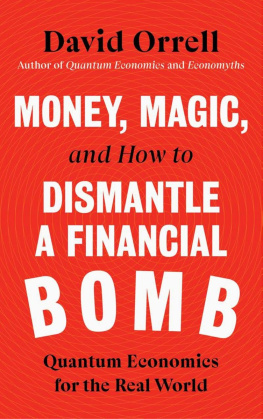
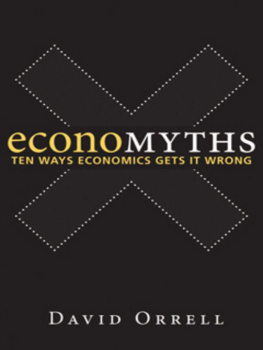

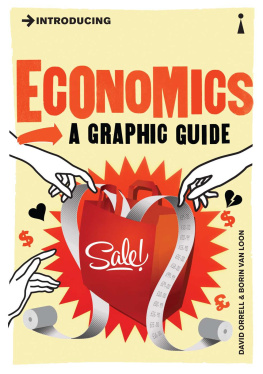
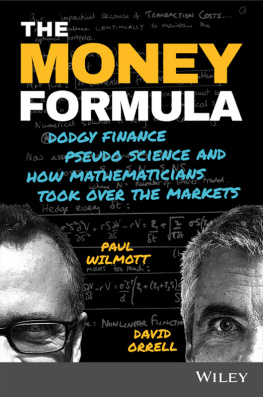
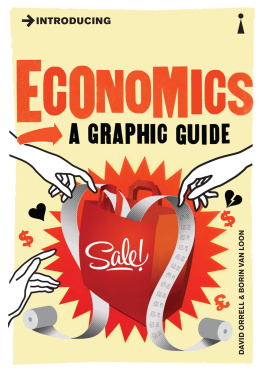
![David Orrell [David Orrell] - Quantum Economics](/uploads/posts/book/114631/thumbs/david-orrell-david-orrell-quantum-economics.jpg)
